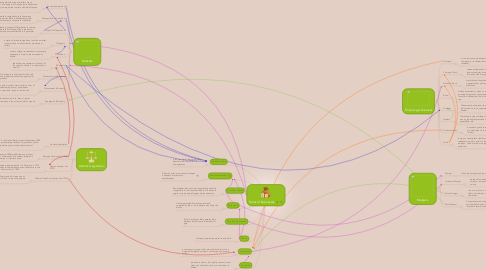
1. Market Structure
1.1. is the number of firms producing identical products which are homogeneous
2. Limited life
2.1. situation in which a firm legally ceases to exist when an onwer dies, quits or a new onwer is added
3. Partnership
3.1. Unincorporatated business owned and operated by two or more people who share the profits
4. Corporation
4.1. a company or group of people authorized to act as a single entity (legally a person) and recognized as such in law.
5. Nonprofit organization
5.1. Ecomic institution that operates like a business but does not seek financial gain
6. Unlimited Liability
6.1. Requirement that an onwer is personally and fully responsible for all losses and debts of a business: applies to proprietorships general partnerships
7. Sole proprietorship
7.1. One who owns or owns and manages a business or other such establishment
8. Charter
8.1. written goverment approval to establish
9. Markets
9.1. Perfect Competition
9.1.1. the situation prevailing in a market in which buyers and sellers are so numerous and well informed that all elements of monopoly are absent and the market price of a commodity is beyond the control of individual buyers and sellers
9.2. Monopolistic Competition
9.2.1. is a type of imperfect competition such that many producers sell products that are differentiated from one another and hence are not perfect substitutes
9.3. Product Differentiation
9.3.1. In economics and marketing, product differentiation (or simply differentiation) is the process of distinguishing a product or service from others, to make it more attractive to a particular target market.
9.4. Oligopoly
9.4.1. a state of limited competition, in which a market is shared by a small number of producers or sellers
9.5. Collusion
9.5.1. secret or illegal cooperation or conspiracy, especially in order to cheat or deceive others.
9.6. Monopoly
9.6.1. the exclusive possession or control of the supply or trade in a commodity or service.
9.7. Technological Monopoly
9.7.1. A monopoly is a firm which is the only one producing and selling a particular product.
9.8. Government Monopoly
9.8.1. In economics, a government monopoly (or public monopoly) is a form of coercive monopoly in which a government agency or government corporation is the sole provider of a particular good or service and competition is prohibited by law.
9.9. Geographic Monopoly
9.9.1. A condition that exists in a local area or region wherein one company is the sole provider of a good or service.
10. Antitrust Lagislation
10.1. Antitrust Legislation
10.1.1. Laws passed in the United States, especially between 1890 and 1915, to prevent large business corporations, called trusts, from combining into monopolies to restrict competition.
10.2. Sherman Antitrust Act (1980)
10.2.1. an act of Congress (1890) prohibiting any contract, conspiracy, or combination of business interests in restraint of foreign or interstate trade.
10.3. Clayton Antitrust Act (1914)
10.3.1. An amendment passed by the U.S. Congress in 1914 that provides further clarification and substance to the Sherman Antitrust Act of 1890.
10.4. Federal Trade Commission Act (1914)
10.4.1. The Federal Trade Commission Act was one of President Woodrow Wilson's major acts against trusts.
11. Financing A Business
11.1. Dividend
11.1.1. a sum of money paid regularly (typically quarterly) by a company to its shareholders out of its profits (or reserves).
11.2. Common Stock
11.2.1. shares entitling their holder to dividends that vary in amount and may even be missed, depending on the fortunes of the company
11.3. Preferred Stock
11.3.1. stock that entitles the holder to a fixed dividend, whose payment takes priority over that of common-stock dividends
11.4. Bond
11.4.1. A debt investment in which an investor loans money to an entity (corporate or governmental) that borrows the funds for a defined period of time at a fixed interest rate
11.5. Principal
11.5.1. The amount borrowed or the amount still owed on a loan, separate from interest
11.6. Interest
11.6.1. The charge for the privilege of borrowing money, typically expressed as an annual percentage rate
11.7. Double taxation
11.7.1. A taxation principle referring to income taxes that are paid twice on the same source of earned income
11.8. Stock
11.8.1. A type of security that signifies ownership in a corporation and represents a claim on part of the corporation's assets and earnings. There are two main types of stock: common and preferred.
12. Mergers
12.1. Merger
12.1.1. when two companies become one
12.2. Hoizontal Merger
12.2.1. between firms who operate in the same space, often as competitors offering the same good or service.
12.3. Vertical merger
12.3.1. two or more firms, operating at different levels within an industry's supply chain, merge operations.
12.4. Multinational
12.4.1. Corporation producing and selling without regard to national boundaries, whose business activities are located in several countries.

